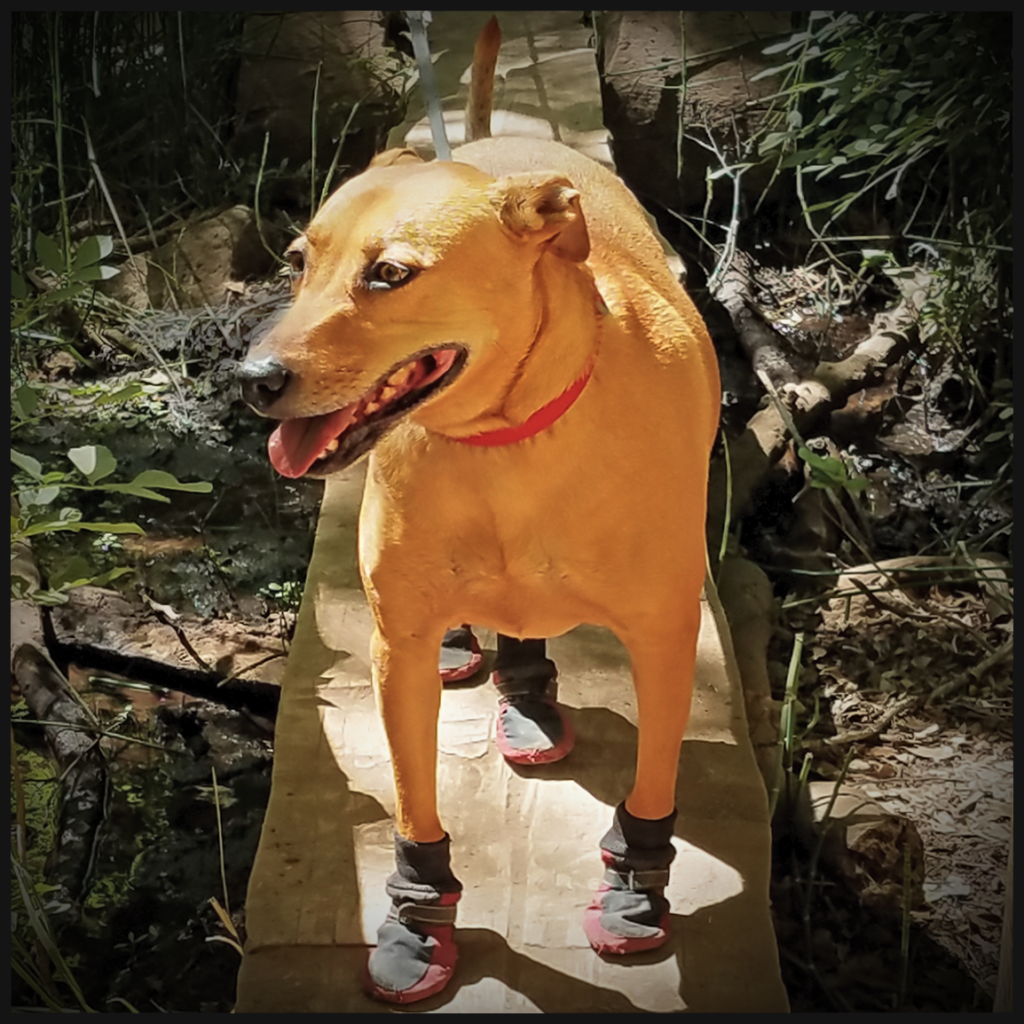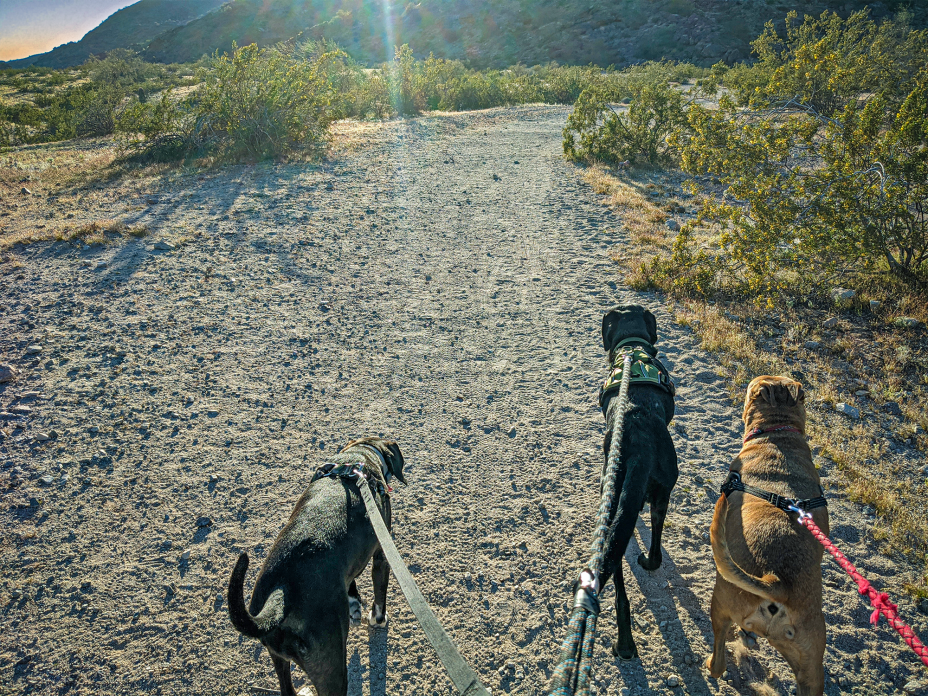Part 1 – Exposure Related Considerations

Like many others, I love hiking with my dogs. Getting out of the house and the yard and into the unknown is an awesome way to bond with my dogs and they certainly love it as well.
I was motivated to write this post because I am an avid hiker here in the Sonoran Desert, and I am a dog-owner of three, typically playful dogs who love nothing more than to go hiking. I have spent over a decade exploring the hundreds of miles of urban hiking trails in and around the Valley of the Sun (Phoenix), in the heart of the Sonoran Desert. And a lot of that exploring has been done with one or more dogs along for the ride.
As a year-round hiker, I am always amazed when the temperatures really start to heat up, to see so many hikers on the trails with little or no water. I see this all year long, but it especially baffles me in the heat. And it’s always a little more concerning when the ill-prepared hiker is dragging a kid or dog along with them.
Hiking with a dog is quite different from walking a dog, even if you consider your walks to be long. Hiking in itself is more than just walking. Hiking infers that there is a level of planning involved (where, when, and who, etc.). A hiker sets out with intention to safely traverse a specified distance or trail and plans for this accordingly. Hiking with a dog should include the same level of planning to include your four-legged friend.
Here in the Sonoran Desert there are some considerations that are vitally important to make in order to be sure you and your dog have a safe and enjoyable hike.
Exposure is the condition of being exposed without protection to the effects of harsh weather, especially the cold. And, exposure in the Sonoran Desert in the summertime takes on a whole new meaning! It is also the leading reason hikers require rescue or assistance. Exposure can lead to a number of serious issues.
Hypothermia (not to be confused with Hyperthermia)
Hypothermia in dogs is an extreme lowering of the body temperature. It happens when pets suffer exposure to frigid temperatures for too long, or if they have wet fur in cold, windy environments. When the body temperature drops, heart rate and breathing slow down, which can lead to several problems. The consequences of sustained, severe hypothermia may include neurological problems (including coma), heart problems, kidney failure, slow or no breathing, frostbite, and eventually death.
If you notice the following signs in your dog, keep them warm and get to an emergency vet for treatment:
• Strong shivering and trembling followed by no shivering
• Acting sleepy or lethargic and weak
• Fur and skin are cold to the touch
• Body temperature is below 95 degrees (Fahrenheit)
• Decreased heart rate
• Dilated pupils (the black inner circle of the eye appears larger)
• Gums and inner eyelids are pale or blue
• Trouble walking
• Trouble breathing
• Stupor, unconsciousness, or coma
Heat Related Illnesses – Heat Exhaustion, Heat Stroke and Hyperthermia
Heat Related Illness and overheating in dogs is not something to take lightly. As the weather heats up, it’s important to remain aware of how the heat affects your pup. Heat exhaustion in dogs can lead to serious and potentially fatal conditions such as heat stroke and cardiac arrest.
Unlike people, dogs don’t sweat out excess body heat. While your dog does have a few sweat glands located in his paws, these do little to help regulate his body temperature. Instead, he does this through rapid, open-mouthed breathing, called panting. But sometimes panting isn’t enough to keep him from getting overheated.
Heat exhaustion in dogs can occur when the body temperature becomes elevated above the normal temperature. This varies slightly, according to PetMD.com, but it’s generally agreed that temperatures of 103 degrees Fahrenheit and higher are above normal. If the temperature continues to rise and reaches 106 or higher, your pup is in the danger zone for heat stroke, during which the organs begin to shut down and his heart could stop altogether.
Fortunately, it’s not difficult to spot signs of overheating in dogs. Excessive panting is the first symptom. A dangerously overheated dog, according to the American Kennel Club Canine Health Foundation, may collapse or experience convulsions, exhibit vomiting or diarrhea, and may also have gums or a tongue that turn blue or bright red. You may want to identify the problem before it gets that severe, though to intervene and prevent serious overheating. Early signs are more subtle – it may be as simple as your dog seems less responsive to commands than usual. When you call his name, instead of turning to look at you, he may wander away. If there is any question at all, get your dog out of the heat. The Humane Society of the United States adds that signs of potential heat stroke include glazed eyes, excessive drooling, a rapid heart rate, dizziness or lack of coordination, fever, lethargy, and loss of consciousness.
Some dog breeds are at greater risk for heat related issues
While all dogs are at risk for overheating if the conditions are right, some breeds are more prone to it than others. This includes dogs with thick coats or long hair, very young or very old dogs, and brachycephalic breeds—those with short noses and flat faces, such as shih-tzus, pugs, boxers, and bulldogs. Overweight dogs and those that suffer from medical conditions that cause difficulty breathing or heart problems are especially susceptible.
Researchers looked only at the characteristics of dogs who were diagnosed with heat illness and didn’t parse out how particular heat conditions contributed to any breed’s risk, nor did they look at how animals’ individual hydration, fitness levels, or average physical activity affected their outcomes.
Extremely active dogs and working or hunting breeds (such as shepherds, retrievers, and spaniels) are also at a higher risk, especially during warm months. You should be careful to not push these dogs too hard, so make sure they get plenty of breaks to rest in the shade and that they are well-hydrated at all times.
• Any dog weighing more than 110 pounds is more vulnerable to heat stress, regardless of breed.
• Dogs aged 12 years and older had much higher susceptibility than any other age group.
• Dogs with flat faces and wide skulls, such as English Bulldogs and Spaniels, are twice as likely to experience heat-related illnesses compared Beagles, Border Collies and other dogs with more pronounced snouts.
• Golden Retrievers are 2.7 times more likely than Labradors to suffer from heat-related illness despite being of similar size, temperament and purpose. The difference may come down to the coat, which is thicker for Golden Retrievers.
• Greyhounds were found to have 4.3 greater susceptibility to heat than Labradors. Although Greyhounds have nice, long noses, thin hair, and are not usually associated with being overweight, they do have a high ratio of muscle, which previous studies have shown correlates to greater risk of heatstroke after exercising.
In a separate study of 54 dogs diagnosed with naturally occurring heatstroke the median body weight of the dogs was 68 lbs, supporting a higher susceptibility of large breed dogs to heat stress. Likewise, several large breed dogs, such as Golden and Labrador retrievers, brachychephalic breeds (e.g., English bulldog) and military working dogs (mostly Belgian and Dutch shepherds) were significantly over-represented in large-scale studies of canine heatstroke.
First Aid
It is essential to remove the dog from the hot environment immediately. Do not give the dog aspirin to lower its temperature; this can lead to other problems. If the dog is unconscious, make sure no water enters the nose or mouth.
• If you’re near a body of fresh water, such as a lake or other water source, let your dog take a dip to cool down. If you cannot submerge your dog in water, place a towel on his back and continue to soak the towel and your dog in cold water. Do not submerge your dog’s head in the water. Keep the head elevated to prevent aspiration pneumonia.
• If he’s conscious and willing to drink, give him cool, fresh water. Don’t force it, however, as it may end up in his lungs. If he can’t or won’t drink, or can’t keep water down, wet his tongue with water instead. Don’t feed him ice cubes, which could cause his temperature to drop too quickly, leading to shock.
• Get him to the vet. If you haven’t already done so, call ahead so they can be ready to take immediate action as soon as you arrive.
Prevention
Prevent heat related illnesses by limiting exposure time to the heat. It really is that simple. Changing the time of your hike from the afternoon to the morning, when temperatures are cooler. Limiting exercise or outdoor activity on excessively hot or humid days, and providing plenty of shade and water when your dog is outdoors. Consider wetting your dog down or using a cooling vest while he’s active, and keep a close watch on him for the first signs of overheating. Many dogs tend to become so focused on their tasks that they don’t realize when they need to rest and cool down. It’s up to you to monitor your dog and make sure he gets the breaks he needs to stay healthy.
In an attempt to help curb the rising number of canine, heat-related incidences from increasing, the City of Phoenix Parks and Recreation Department passed laws in 2016 that ban residents from walking dogs in public parks and on city-owned hiking trails when the ambient temperature reaches 100° F. In surrounding cities like Scottsdale, where no such ban exists a dog owner can and will likely be prosecuted for animal cruelty if emergency assistance is required during periods of excessive heat warnings.
When monsoons roll into the Sonoran during the month of June, temperatures are typically above the 100° mark so dogs shouldn’t be out on the trails. It should be noted though, that the higher humidity during monsoons make it that much more difficult for your dogs natural cooling system to work efficiently.

Many hikers-with-dogs want to provide their dogs comfort by fitting them with ‘shoes’ or booties. I learned a couple seasons back that although this might be helpful for preventing injury on sharp or jagged surfaces, dog shoes shouldn’t be relied upon to provide protection from walking on hot surfaces. The very few sweat glands your dog has are on their paws, so covering them up when it’s already hot can be problematic. If the surface temperature of the ground is too hot for you to walk on barefoot, it’s too hot for your dog to walk on – and if the surface temperature of the ground is too hot to walk on, it’s likely too hot for your dog to be able to keep themselves cool as well.
Finally…Always, always…ALWAYS! Bring more water than you believe you will need, for both yourself and your dog. Bring a bowl or something your dog is comfortable drinking from. There are soft, nylon bowls that are collapsible and can be stuffed into your pack. Some trailheads have facilities and fresh water supplies, but always bring your own. You can never be sure if the supply will be available, and if you show up to the trailhead without water, there is a much greater chance you will risk hiking without it…don’t be that hiker, don’t be that dog owner!
Leave No Trace
From a Leave No Trace perspective, Principle #1 – Plan Ahead and Prepare, covers a lot of what was just discussed. Plan ahead by knowing the weather, the temperature and humidity and determining whether it’s safe and practical to take your dog out with you. Prepare ahead of time by procuring your water and water for your dog’s hike.
Sources:
Pathophysiology of heatstroke in dogs – revisited Burchim, Horowitz, and Aroch – October 29, 2017 U.S. National Library of Medicine
Hypothermia in Dogs: Symptoms, Causes and Treatments Christine McLaughlin, DogTime.com http://www.dogtime.com
Heatstroke in Dogs Vladimir Negron – August 16, 2010 http://www.petmd.com



